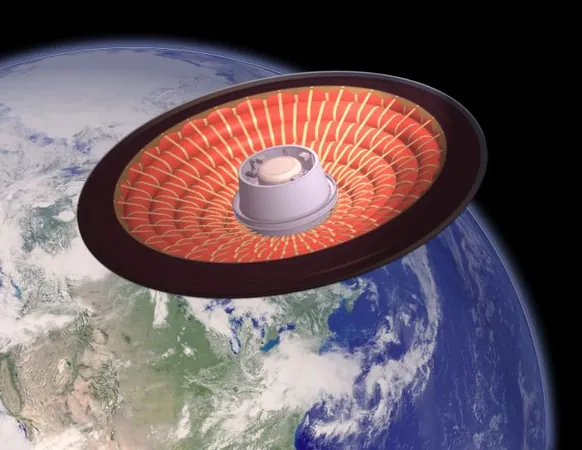
Inflatable Heat Shields: The Future of Safe Atmospheric Re-Entry!
2024-11-06
Author: Siti
Navigating spacecraft safely through the fiery embrace of planetary atmospheres has long been a formidable challenge.
With their lightning-fast speeds and oppressive heat, re-entering vehicles must overcome numerous obstacles to ensure safe landings, paving the way for the return of both large objects and critical cargo from space.
The Evolution of Heat Shields
Heat shields are not a recent invention; their design and technology have been progressively refined since the 1950s. Early explorations saw the development of ablative heat shields that were used in prestigious missions like Apollo and Soyuz, designed for single usage as they burned away upon re-entry.
The 1980s brought forth advancements with the revolutionary ceramic shield tiles used in the Space Shuttle, which provided a lightweight alternative.
Fast forward to today, where NASA's Orion spacecraft utilizes advanced epoxy resin in a fiberglass honeycomb, retaining its lightweight properties while striving for effective cooling. However, these technologies still do not match the versatile potential that inflatable heat shields promise.
Inflatable heat shields, developed by NASA over the last two decades, are bringing fresh possibilities to space exploration. They are not only lightweight but can also be compactly stored, making them ideal for various applications, including landing cargo on distant planets like Mars.
The Technical Breakthrough of ICARUS
Professor Ali Gülhan of the German Aerospace Center (DLR), a key figure in the ICARUS project, highlights the limitations of current atmospheric entry vehicles, which are typically outfitted with rigid thermal protection systems that struggle against high speeds and intense thermal loads.
The proposed inflatable design could significantly increase the drag area during re-entry, providing safer landings for heavy payloads even in low-density atmospheres.
The main advantage of an Inflatable Heat Shield (IHS) is its clever construction. The shield expands into a larger diameter upon deployment, which subsequently reduces the thermal and mechanical stresses during re-entry.
This innovation not only decreases weight but also opens the door to massive cost savings and improved reusability for various spacecraft technologies.
Simone Centuori, CEO of Deimos—leading the ICARUS project—emphasizes that achieving safe re-entry while preserving the integrity of the spacecraft is the ultimate goal.
The inflatable system's design allows it to function as both a thermal protection system and a decelerator, thus ensuring that large payloads can return safely to Earth.
A Partnership with NASA and Future Endeavors
NASA's robust advancements in IHS technology, including successful HIAD and LOFTID missions, have set the stage for future projects.
The research into inflatable heat shields is critical for not only ensuring the reuse of rockets but also for enabling deeper space exploration missions, such as bringing back precious samples from Mars or other celestial bodies.
The ICARUS initiative is derived from earlier European projects aimed at improving knowledge and capabilities related to inflatable heat shields, building a comprehensive framework for future missions.
With an upcoming timeline that includes discussions kicking off at the end of 2022 and developmental phases leading up to a 2028 launch, the road ahead is promising.
Testing, Challenges, and Innovation
Crucial ground and space testing will precede the anticipated launch, ensuring the inflatable structure can withstand the demanding conditions of re-entry.
Engineers are keen to evaluate the deployment efficiency, structural integrity, and overall operational capacity of their designs in a full-scale mechanical stress test.
The rigorous testing process will also involve state-of-the-art facilities like the Italian Space Agency's Scirocco Plasma Wind Tunnel, where high-temperature plasma jets simulate re-entry conditions.
As the demand for reusable spacecraft grows and as humanity eyes the possibilities of deeper space exploration, the ICARUS project stands as a potential game-changer; it could redefine safety standards for meteorological and exploratory missions, leading to a new era in space travel.
Don’t miss the exciting advancements coming from Europe! Stay tuned as the ICARUS project unfolds, making strides toward not only returning precious cargo but possibly ushering in new standards for interplanetary travel and habitation. The sky may soon be no limit!



 Brasil (PT)
Brasil (PT)
 Canada (EN)
Canada (EN)
 Chile (ES)
Chile (ES)
 España (ES)
España (ES)
 France (FR)
France (FR)
 Hong Kong (EN)
Hong Kong (EN)
 Italia (IT)
Italia (IT)
 日本 (JA)
日本 (JA)
 Magyarország (HU)
Magyarország (HU)
 Norge (NO)
Norge (NO)
 Polska (PL)
Polska (PL)
 Schweiz (DE)
Schweiz (DE)
 Singapore (EN)
Singapore (EN)
 Sverige (SV)
Sverige (SV)
 Suomi (FI)
Suomi (FI)
 Türkiye (TR)
Türkiye (TR)